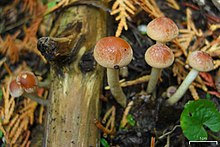| Pyrrhulomyces astragalinus | |
|---|---|

| |
| Scientific classification | |
| Domain: | Eukaryota |
| Kingdom: | Fungi |
| Division: | Basidiomycota |
| Class: | Agaricomycetes |
| Order: | Agaricales |
| Family: | Strophariaceae |
| Genus: | Pyrrhulomyces |
| Species: | P. astragalinus |
| Binomial name | |
| Pyrrhulomyces astragalinus (Fr.) E.J. Tian & Matheny (2020) | |
| Synonyms | |
List
| |
Pyrrhulomyces astragalinus, commonly known as the pinkish-orange pholiota, is a species of fungus in the family Strophariaceae. It was first described scientifically in 1821 by Elias Magnus Fries as a species of Agaricus. Rolf Singer transferred it to the genus Pholiota in 1951 and the species was transferred to its present genus in 2020 by E.J. Tian & Matheny. The fruitbodies of the fungus have pinkish-orange caps measuring 2–5.5 cm (3⁄4–2+1⁄8 in) in diameter. The flesh is orange, blackening in age, with a bitter taste. They produce a reddish-brown spore print, causing it to be placed in its genus rather than Hypholoma, which it resembles. The spores are oval to elliptical, smooth with thin walls, and measure 5–7 by 4–4.5 μm. In North America, the fungus is found in the United States and Canada. In Europe, it has been recorded from France, Sweden, and Switzerland. Its mushrooms usually grow singly or in small clusters, sometimes on conifer logs.
Though nonpoisonous, the species is regarded as inedible.
References
Species of fungus| Pyrrhulomyces astragalinus | |
|---|---|
| Gills on hymenium | |
| Cap is campanulate or convex | |
| Hymenium is adnexed or free | |
| Stipe is bare | |
| Spore print is brown | |
| Ecology is saprotrophic | |
| Edibility is inedible | |
- "GSD Species Synonymy: Pyrrhulomyces astragalinus (Fr.) E.J. Tian & Matheny". Species Fungorum. CAB International. Retrieved 2024-02-28.
- Arora, David (1986). Mushrooms demystified: a comprehensive guide to the fleshy fungi (Second ed.). Berkeley: Ten Speed Press. ISBN 978-0-89815-169-5.
- Singer R. The Agaricales in Modern Taxonomy. Lilloa. Vol. 22 (2 ed.). Weinheim, Germany: Cramer. p. 516.
- ^ Trudell, Steve; Ammirati, Joe (2009). Mushrooms of the Pacific Northwest. Timber Press Field Guides. Portland, OR: Timber Press. pp. 173–174. ISBN 978-0-88192-935-5.
- Bessette A, Miller OK Jr, Bessette AR, Miller HR (1995). Mushrooms of North America in Color: A Field Guide Companion to Seldom-Illustrated Fungi. Syracuse, New York: Syracuse University Press. pp. 66–67. ISBN 978-0-8156-2666-4.
- Miller Jr., Orson K.; Miller, Hope H. (2006). North American Mushrooms: A Field Guide to Edible and Inedible Fungi. Guilford, CN: FalconGuide. p. 261. ISBN 978-0-7627-3109-1.
- Phillips, Roger (2010). Mushrooms and Other Fungi of North America. Buffalo, NY: Firefly Books. p. 202. ISBN 978-1-55407-651-2.
| Taxon identifiers | |
|---|---|
| Pholiota astragalina | |
| Agaricus astragalinus | |
This Agaricales-related article is a stub. You can help Misplaced Pages by expanding it. |